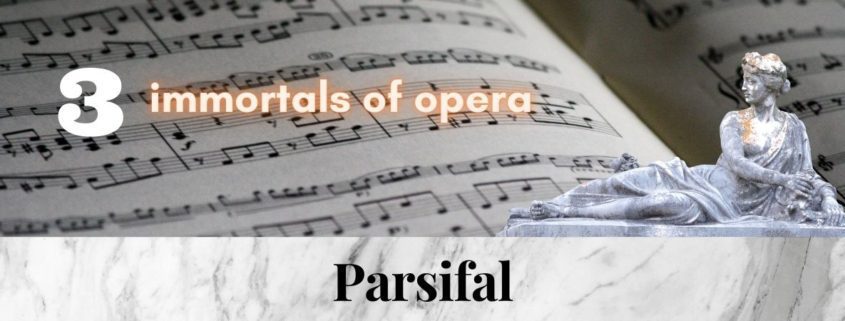3 immortal pieces from the opera PARSIFAL by Wagner- with the best interpretations from YouTube (Hits, Best of)
Like Verdi’s Falstaff and Puccini’s Turandot, “Parsifal” belongs to the last, age-wise words of a master. With “Parsifal”, Wagner was striving for something universal that would elevate the practice of art to the rank of a festival, a “stage-festival consecration play”, in Wagner’s words. This turned into a unique work that still captivates the listener with its mythical-religious theme and its spiritual and musical content.
The programmatic prelude
Synopsis: In a forest in the mountains of northern Spain. Not far from the Grail icastle Montsalvat.
Right at the beginning, the “love feast motif” is heard, an expansive theme:
The syncopated form is particularly striking; there is no sense of meter and a feeling of rapture, of floating. Wagner himself called it the central musical theme of this work. It will become the musical motif of the communion ritual of the finale of Act 1. Wagner created with this long theme a (in Wagner’s words) “basic theme,” in the sense that it can be broken down into three parts, each of which becomes a new motif again! We find the first part in the Grail motif, the second (minor) part becomes the pain motif and the third part becomes the spear motif.
After 3 times appearance of the love feast motive, we hear the so-called Grail motive, another central leitmotif of this work:
Right after that we hear the third important motif of the prelude. It is the short but powerful motif of faith:
In the first part of the prelude, we entered the musical world of Montsalvat, whose music was largely diatonic. With the sounding of a tremolo, the music becomes more chromatic and is dedicated to the thematic complex of suffering.
Vorspiel – Knappertsbusch
The famous transition music
The Grail Knight demands to know the name of the hunter. Parsifal declares that he does not know it. Kundry explains that he was raised as a fool by his mother Herzeleide. Gurnemanz then invites the young man to the castle, hoping to have encountered the fool who will once steal the spear from Klingsor.
As Gurnemanz and Parsifal make their way to the castle, the magnificent transformation music is heard, introduced by the bell motif:
Verwandlungsmusik – Karajan
Wagner’s Grail Bells
As Gurnemanz and Parsifal approach the castle, they hear the bells. Wagner wanted a special bell sound, “two octaves lower than the bells of St. Stephen’s Cathedral in Vienna”. But this would have required four bells of 280 tons of steel for the four notes. Wagner had the Bayreuth piano manufacturer build an unusual instrument that produced the peculiar sound Wagner wanted. In the twenties, Siegfried Wagner and the conductor Karl Muck rethought and the result of the instrument makers looked like giant wine barrels with strings stretched over them. Unfortunately, they were melted down during the war years. They can still be heard in a recording by Muck from the twenties and seen in a photograph.
The Good Friday spell
Parsifal, for his part, turns to Kundry and performs the baptism to redeem her from her torment and guilt. Parsifal recognizes the beauty of nature and life again for a long time.
Wagner called this famous scene, which takes place after Kundry’s baptism, “Good Friday spell,” which, like the Waldweben, is an orchestral interlude inspired by Beethoven’s Pastorale. It is characterized by the so-called flower meadow motif, which is played by the oboe and describes the graceful colors, shapes and scents of the forest and meadow:
Wie dünkt mich doch die Aue heute schön – Thomas / Hotter












Leave a Reply
Want to join the discussion?Feel free to contribute!